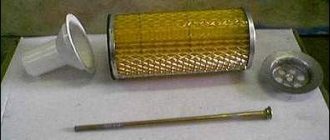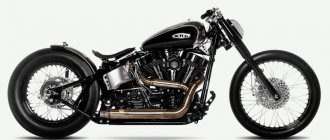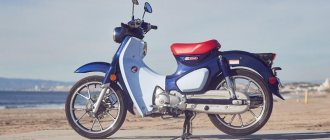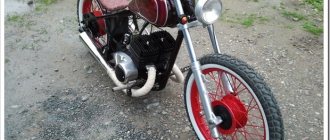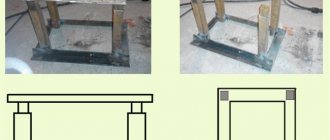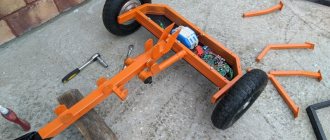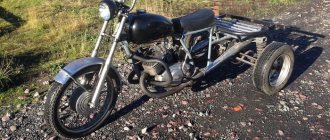We recommend
DIY bicycle differential
DIY cruiser bike
Assemble an electric bicycle with your own hands
To make a bicycle yourself, you need to be well versed in the design of bikes, have a clear understanding of their structure and geometry, as well as know the operating features of the mechanisms and parts used.
The appearance and functionality of such a hand-made bicycle are limited only by the imagination and capabilities of the person who assembles it.
001_MOTO_0610_064
But the engine worked like a clock. But when I got my appearance in order, a friend decided to take my Hurricane for a ride and... got into an accident. I had to pick up my dream piece by piece. The fairing and side plastic mounts suffered the most. The mufflers were dented so badly that they interfered with the normal operation of the pendulum. The fairing was crushed, the motorcycle lost its newly installed turn signals and mirror, and the instrument panel was torn from its mounts. Parts hidden from view, including the frame, were also severely damaged. Not even the ignition key survived. I decided to make the motorcycle more reliable, safer, and at the same time “rejuvenate” its appearance. I didn't have to cover a bunch of paper with drawings, sketches and notes. The new cladding was born in thoughts, developed and came into being in one breath. I decided to do the work sequentially, moving from simple parts to more complex and labor-intensive ones.
About custom motorcycles
From English the word “ custom
”
is translated as “made to order”. The main idea is to make the motorcycle the way the owner wants it, from technical features to appearance. Typically, custom cars are assembled based on serial models, replacing parts or adding to the design. Less often, they are assembled completely from scratch, taking as a basis either only the frame from the bike, or creating the frame themselves.
Custom shops such as the American Orange County Choppers and West Coast Choppers and the Russian King Kong Custom, Fine Custom Mechanics, Motodepo CS make amazing customs. The whole world watches their work and then other masters try to repeat it.
Motorcycle manufacturers such as Honda, Harley-Davidson and others add the word "Custom" to their model names. But these are not custom bikes, they just have great potential for creating custom motorcycles, that is, they can easily be altered or modified.
Is custom safe?
If you order a customized bike from a workshop, then the answer is a clear yes. Because in this motorcycle the load will be correctly distributed between the parts, the rigidity of the structure and other technical parameters will be calculated.
When modifying a bike yourself, in order to make a high-quality bike, you will have to carefully calculate the required parameters and dimensions. Be sure to first make a draft of the future custom motorcycle on paper.
003_MOTO_0610_065
The idea to cage the motorcycle in a cage of protective bars was born immediately after an unsuccessful slide and flip. Following the advice of an experienced stunt rider, I secured its bases with clamps. Damage to the frame from falls will be minimal, and, in addition, the cage can be easily removed and repaired. The protection is welded from 36 pieces of steel pipe with a diameter of 22 mm. An all-metal rod is hidden inside, which adds strength. If you fall, the front fork will inevitably twist, but the handles, clip-ons, turn signals and, most importantly, the hands will remain unharmed, because the upper “protection” fastenings are located directly under the handles and at a sufficient distance from the facing. Fortunately, I haven’t had to try this in practice yet. But with the protective bars, rolling the motorcycle and placing it on the center stand has become much more convenient.
What is customization and who is a customizer?
Customizing is a process or type of activity that is associated with altering a motorcycle to meet specific needs. Essentially, this is external and internal tuning of bikes. In Russia, customization has been widespread for quite a long time, since they began to modify and replace parts on Urals, Izhi, Java and other Soviet motorcycles.
A customizer is a person who customizes a motorcycle, he may work in a workshop or do it for fun in his own garage.
Old Soviet motorcycles make incredible projects! Today I propose to take a look at 9 of the most amazing customs, in my opinion, built on the basis of USSR motorcycles.
Dnepr Brigadier by Falcodesign studio
The first custom is called Brigadier. Its construction was carried out by the Belarusian studio Falcodesign, which is already known for its custom designs based on the Dnieper. However, this bike turned out to be so cool that it immediately entered all the world customizer charts.
Planet Sport from Yuriy Shif Custom
In the Minsk workshop of Yuri Shif, not just motorcycles are created, but works of art. IZH Planet Sport is a legendary device that still has many fans. However, there are those who are not satisfied with it. In 2015, a specialist from Belarus, Yuri Shif, presented a custom project from this Soviet monster. And he looks amazing!
So, on the basis of the Soviet IZH, an original scrambler from the Yuri Shif Custom company was born, which was manufactured for a Moscow owner. The motorcycle has a lot of new things: brake discs on the wheels, new suspension, forks, handlebars, and much more. As for the engine, it has been significantly improved: power has increased from 32 to 50 hp. and the ability to turn it up to 11,000 rpm.
Сafé-racer Minsk Detonator
This bike was also made by Belarusian customizer Yuri Shif and was awarded prizes at various motorcycle competitions abroad. Everyone has probably already heard about the fastest M1NSK. This is a concept with a 125cc two-stroke engine. It can reach speeds of up to 205 km/h. The chassis of the highway-ring “Minsk”, produced in the 1980s, is taken as the basis.
Minsk Detonator was named best in the “Born in the USSR” category and second in the “Metric Motorcycle” category. He also finished in the top five overall.
Iron Custom Motorcycles Beckman
The Beckman motorcycle was assembled in the Kharkov Iron Custom Motorcycles workshop for nine months. Last year, the Kharkov bike became the best at the World Motorcycle Customization Championship, held in Cologne, Germany. The craftsmen created a project based on IZH Jupiter-4 produced in 1982, but there were almost no original parts left in it, since most were created by hand by craftsmen.
The homemade engine increased the bike’s power from Izhevsk’s 28 hp. up to 50 hp And Beckman received its name in honor of the Soviet design engineer and racer Wilhelm Beckman - based on his books and articles, the masters built a custom one.
Custom IZH Jupiter
Many should be familiar with the work of Moscow designer Mikhail Smolyanov. It’s as if he looked into another era, customizing the IZH Jupiter for motorcycles of the early 20th century. What else can I say, it turned out to be a real masterpiece.
Steampunk Fritz Project
The Fritz project in the steampunk style was implemented based on the components of the Dnepr motorcycle by craftsmen from Germany. Pay attention to the sidecar with a car radiator from the 20s; it gives a special charm to the motorcycle.
PanUral from IBCycles
This project, called PanUral, is the brainchild of the Italian studio IBCycles, which was presented at AMD-2016. All elements of this Kolskaya motorcycle are made of aluminum, which is what all elements of this project are made of. The engine here remains from the Urals.
Project The Machine by Yuri Shif
Here is another interesting project “The Machine” from Yuri Shif. This work, built on the basis of the Russian K-750 motorcycle, became one of the most successful. The project became the 2010 world champion in the USA in the class of motorcycles with non-American engines, and also took 3rd place in the overall standings. In addition, “The Machine” is the winner of the International Championship of Germany Custombikeshow 2010.
The Machine shocked not only specialists, but also the public, spoiled by design and technical delights. The bike was developed in the strictest secrecy and its premiere became a sensation even for people close to the Minsk customizer. A stunning appearance that takes you back to the distant 30s, the highest technical performance, fantastic design solutions for the chassis. The heart of the bike was a futuristic power plant, based on a twin boxer pair from the legendary model of the Soviet motorcycle K-750, with a screw compressor mounted on top!
Electric Volga by Mikhail Smolyanov
Russian designer Mikhail Smolyanov, commissioned by Electric Cars Custom, created a prototype of an electric cycle called Electric Volga. The concept follows the shape of the GAZ 21 Volga car from the middle of the last century, but stands on two wheels and is packed with high technology.
Massive body elements are made of aluminum, and the frame is made of steel pipes. The EV Drive power unit can produce from 160 to 253 Nm depending on the voltage, spins up to 10,000 rpm and produces about 134 hp. The concept’s speed performance is even more impressive: acceleration from 0 to 100 km/h is 2.5 seconds, and the “maximum speed” is limited to 200 km/h.
DIY chopper, or maybe buy a ready-made motorcycle? This is a question asked by many motorcyclists, especially beginners, who have long decided for themselves that they will not ride a plastic sport, but a real iron motorcycle, in which the sound of the legendary V-twin produces a solid sound, and not the sound of a screeching coffee grinder. In this article, which is more aimed at beginners in the interesting art of customization, we will look at what you need to make the right chopper with your own hands, and how to make many details for it that will make it quite original and have a cool appearance .
It’s not so easy to write how to build a chopper with your own hands, since there are now a huge number of styles of customized motorcycles (custom), and their coolness directly depends on the number of banknotes, the skillful hands of the master and the equipment he has in his garage. And when reading about the construction of a specific custom, some novice customizer may simply not be able to manufacture it, due to a lack of funds and the necessary equipment. Or he simply may not like the style of some custom, because there are a lot of styles.
Therefore, this article will not describe the construction of any specific custom of a certain style, and my recommendations in this article will be purely conditional, but I still hope they will be useful for novice customizers. In addition, when building any chopper, quite a lot of nuances may arise that cannot be described in one article.
But for a more detailed explanation, when making some parts for a chopper with my own hands, I will put the appropriate link, by clicking on which the dear reader will be able to study in more detail and detail the manufacture of some equipment or some part of a chopper, and successfully apply this knowledge at home in the garage. And so let's go.
What you need before you start making a chopper with your own hands.
The first thing you need to do before starting work is decide on a budget. After all, the right chopper, which in terms of workmanship and coolness can easily outperform a serial factory bike, requires a certain investment of money. And the larger these investments, the cooler the finished custom will turn out.
Of course, with certain skills in working with metal and the availability of appropriate equipment, tools and materials, you can make a decent chopper without large investments. But many novice motorcyclists do not have the skills, equipment, or suitable materials. And a significant part of the money will be spent on high-quality tools, materials and some devices, which will be described below, and without which you can’t do anything with your bare hands.
And of course, the bulk of the money will be spent on buying the donor’s motorcycle; you can’t live without it. After all, you can’t make an engine and a frame with a number and the corresponding documents on your own, even if you have super expensive equipment in a workshop (you can make a frame from scratch, but it will be numberless). Moreover, some parts from some donor motorcycles can be used.
This is the same engine, a part of the frame with a number, a front wheel (not always, but often used after modification), a front fender (of course also redone), a front fork and other parts that, with certain skills and tools, can be changed beyond recognition.
In order to save a significant amount of money, you can buy a donor motorcycle in poor condition or damaged, the main thing is that it has the documents in order and that after the accident the engine and the number on the frame are preserved. The engine, documents and part of the frame with a nameplate or number on it are the main things you need to build a chopper, and everything else can be made yourself, or purchased from catalogs.
And after buying a donor’s motorcycle, before you start disassembling it, cutting it and doing anything with it, of course you must first re-register it in your name, register it, and I wrote how to do this correctly (the legalization of a homemade bike is also described in detail there ). This will help avoid problems in the future.
And the serial frame itself, in addition to expanding its rear part, will also need to be modified. For example, in the steering columns of domestic motorcycle frames, there are still weak bicycle-type thrust bearings, which wear out very quickly and the handling of the motorcycle is, to put it mildly, lame. And the first thing you should do is replace these bearings with more powerful conical ones (such as in the Dnepr and Uralov wheels, but one size larger).
To do this, the standard bearing cups are cut off from the frame, and cups of slightly larger diameter are welded in their place, into which the outer races of the tapered bearings are subsequently pressed. I wrote more about this in, as well as in an article about the geometry of motorcycle frames, and the link to this article is below in the text.
The frames of modern imported motorcycles already have more or less normal bearings from the factory, but even such frames have plenty of modifications. Since even imported serial frames are heavier and uglier than homemade frames made from scratch, and from most serial frames (especially Japanese motorcycles) excess parts have to be cut off to lighten the weight.
Of course, there are a large number of types of frames (we read what types of frames there are) and everyone chooses their own option. But now old-school style choppers are very popular, which have very light hardtail-style frames (translated as rigid), which do not have a rear suspension and therefore have beautiful classic lines of a triangular rear part. And such frames are the lightest.
And although it is quite uncomfortable to drive on our roads on such frames, beauty and style require sacrifice. And such devices are designed not for long trips, but for short rides around the city, or for moving the driver’s body from bar to bar. And choppers with such frames are very popular now.
The front fork can easily transform the appearance of any chopper, and can change not only the silhouette, but also the driving performance of your motorcycle. Although, again, when building a chopper, most customizers, as a rule, do not pay attention to handling and comfort, the main thing is the appearance, which determines the coolness of the chopper and which can cause significant excitement in gray city traffic.
Of course, in addition to the fork, the silhouette and driving performance of the motorcycle are influenced by the angle of the steering column, and to be precise, by the trail and rack, which should be taken into account when remaking the frame or making it from scratch. This topic is worthy of a separate article, which I wrote, and I recommend reading in detail about the angles and geometry of the frame. The same article describes in detail the modification of frames of domestic motorcycles and the replacement of bearings with tapered ones.
The most popular type of modification of serial forks is to lengthen them with special inserts and replace the yokes with wider ones, or simply polish the standard yokes. When lengthening the fork stays, in order not to lift the frame relative to the ground and maintain a beautiful silhouette and low ground clearance, you should increase. That is, to ensure that after installing a longer fork, the ground clearance (the distance from the lower frame tubes to the ground) remains the same as it was.
But most often the ground clearance (clearance) is lowered by a factor of two, and in addition to the stronger tilt of the fork, the lowering is also affected by the alteration of the rear part of the frame (moving the rear wheel axis higher than it was in stock). With all this work, it is very important to maintain the clear geometry of the steering column and the entire frame, and such alterations can be carried out correctly only if you have a slipway (the link to the article about the slipway is located above, in the list of tools and accessories).
So installing an extended fork is not so simple and will entail a number of serious alterations to the frame itself and its steering column, taking into account the correct angles (rack and trail - there is a link about them just above, about the angles of the steering column).
But now old-school and bobber-style motorcycles have become very popular, in which the fork (usually a springer) does not extend, or extends only slightly. But changing the angle of the steering column is also quite often used on these devices.
Indeed, with a greater angle of the steering column, even with a short fork, the silhouette of the custom bike improves significantly (it becomes more rapid). At the same time, the ground clearance is only a couple of centimeters and it becomes difficult to drive on our roads with such a device. But still, for many this is not important, because beauty requires sacrifice.
For so-called free-style choppers, a gas tank with a concave bottom, the manufacture of which I described, may be suitable. Well, if anyone is interested in seeing how I made a more complex tank, then watch the video below, which I published on my suvorov-custom channel as a guide for beginners and in order to fill the gap on this topic on the Russian-speaking Internet. I have no secrets and I think it will be useful for beginners to watch this video, divided into three parts.
Of course, beginners should first try to make a simpler classic tank, and as they gain some experience, move on to more complex products. But still, even when making a more complex tank, in the video below, there are some tips that I hope will be useful to novice customizers. By the way, on my channel suvorov-custom (on YouTube) there are other videos on working with sheet metal and I hope over time, as I have free time, I will try to publish more such videos, and in order not to miss new videos, do not forget to subscribe to channel.
As for the wings, of course, like the tank, they should also match the style. And for example, bobbers or radical choppers may not have a front wing at all, and the rear wing is usually very short. But it’s still better to make a wing for a chopper from scratch, since altering a standard wing does not always coincide with the style of the future custom one. In addition, an exclusive wing made from scratch will be one and only, and this will add coolness to it.
And while you can do without a leather canopy, you can’t do without a seat. But I described how to make a seat for a chopper with your own hands from scratch, and it describes two options for making seats, with a plastic base and with a metal one.
Well, under the article I publish a useful and interesting video that proves that with skillful hands and a bright head, you can make an excellent custom even from an ancient Japanese motorcycle, and the engine of this motorcycle is not a twin at all, but an inline four. But it doesn’t spoil the look of the custom at all.
This video once again proves that you can make a unique custom even from trash, and I hope that this video will be an incentive for beginners and will serve as an impetus for them to start further work.
Well, I hope that this article will at least a little help beginners build a chopper with their own hands, and maybe in the near future, you will take this matter more seriously and make this exciting activity your main source of income, good luck to everyone!
Bicycles called Custom are fundamentally different from others. Usually these are handmade bikes, made to order or made by hand. They have a unique geometry that exactly fits the owner's requirements.
In Russia, a club of custom bike enthusiasts “RASTAbike” (Russian Association of Homemade Transport Apparatuses) was even formed. “Rastabike” is a chopper or cruiser with wide tires and a special frame. and a fork are cooked with your own hands. The most important thing in this matter is that your bike will be one and only. You can come up with a design yourself that will make your bike stand out from others.
005_MOTO_0610_065
The mirrors, fairing, rear and lower parts of the motorcycle were made from sheet metal. When creating iron cladding, I was inspired by the fact that I had never seen anything like it, as well as by the skeptical attitude of certain individuals. The only disadvantage of metal is its weight, but the structure made of iron plates 0.5 mm thick is not much heavier than high-quality plastic, but incomparably stronger. In my opinion, working with steel is much easier than working with plastic.
Types of carbon fibers
Carbon frames may differ in the way they are weaved. Let's look at the most popular of them.
HMF
This type of fiber increases the strength of the bicycle and significantly reduces its weight. Due to the perfectly selected ratio of layers and their location, the strength and rigidity of the entire structure are correctly combined. This type of fiber is ideal for people who want to purchase a durable sports “tool”.
HMX-SL
This type of material clearly could not do without the use of nanotechnology. Thin carbon fiber tubes are boldly impregnated with epoxy. The frame was reinforced with T1000G fibers, which have high tensile strength. This material is often used in the manufacture of spaceships. This frame not only has high strength, but also moderate rigidity.
HMX
Such fibers are actively used only by Scott engineers. Its rigidity is 20 percent higher than other types of carbon. At the same time, the weight remains the same. This fiber is the most high-tech of those presented above. But the cost of a bicycle frame made from HMX fibers is three times higher than the cost of a frame made from HMF.
009_MOTO_0610_065
I paid special attention to the exhaust system. I put new, longer and wider ones (they were made at the factory) directly on the crumpled standard mufflers. The size of the mufflers is directly related to safety - in the event of a fall, it is they that will take the entire impact, the “tail”, all the legs and footrests will remain unharmed. With the new mufflers the sound became lower and boomier, especially at low speeds.
Do-it-yourself nod made of carbon fiber, carbon fiber of any length.
However, this is not a reason not to use real carbon in computer modding.
There are quite a lot of different options for making carbon fiber parts and you can easily dedicate several articles to them, but only two of them are suitable for home use, unless, of course, you have a vacuum pump and an autoclave at home. We’ll talk about these methods today. Using these methods will not reveal the full potential of carbon fiber, but this is not always required, for example, often only the excellent appearance of carbon fiber (special carbon texture) and only a small fraction of its strength are needed.
The first manufacturing method is to cover the required part with carbon fiber impregnated with a polymer resin, and the second is to manufacture the part from carbon using a mold (the so-called matrix). The first method, as you might guess, is simpler, but it is more suitable for decorative design since not all the positive features of carbon can be taken advantage of (for example, in this case it will not be possible to save weight), while the second method allows you to take advantage of a large number of advantages provided by carbon fiber, but it also takes significantly more time and effort.
To clearly demonstrate both manufacturing methods, we will use videos from the company CarbonMods, which sells carbon fiber and various accessories associated with it, including special kits with which you can both cover a part with carbon fiber and make the required part from carbon fiber in at home - this is what will be discussed in these videos. Although the videos use special kits that are sold as a separate product by CarbonMods, the methods for working with carbon fiber shown in the videos are applicable not only to these kits, but also to any other carbon fiber and polymer resin.
006_MOTO_0610_065
The new rear optics consist of foglights from Lada-Kalina with implanted red LEDs. The standard, glaring headlight was replaced with more accurate and modern high beam headlights in the center and two fog lights, designed to provide low beam, at the edges. The optics cope with the task no worse than native ones. I deliberately painted over the transparent glass of the windshield so that there would be no desire to stick to the gas tank and “unscrew” as much as possible. The fairing is topped with the same struts with new, longer homemade mirrors - visibility in them is much better than before. The turn signal spark plugs seem to have been created for this motorcycle, and they are even brighter than before, despite their miniature size.
Is it worth doing it yourself?
In addition, making a two-wheeled horse yourself is not the easiest task. Of course, for those who like to create something with their own hands and want to know absolutely everything about their bike, this process will seem pleasant and not difficult, but, nevertheless, it takes quite a lot of time, especially if the custom design involves some original features or even radical changes.
However, assembling your own original vehicle can do without such fundamental changes as designing and welding a new frame and completely changing the appearance of your two-wheeled friend. A huge number of cycling enthusiasts who prefer to assemble their own bikes, in most cases, only use many different parts from a large number of different models. Thus, they select exactly what suits them specifically, take into account their own individual preferences, and also equip their iron horse with only the necessary properties and functions, excluding unnecessary ones.
For example, when assembling his own touring bike, a bike owner can replace a regular steering wheel with a road one, which will be more comfortable to hold on to on a long trip, lighten the weight and increase strength by changing the frame to a light and strong titanium one, replace the brakes with newer and more reliable ones that will not let you down. long journey and make many other modifications. All this will give the custom unique properties and an unusual appearance.
However, when modeling a completely new design, it is important to have a clear sequence for purchasing and assembling parts. Not all parts can fit neatly together
Quite often, models of parts from different manufacturers and for different types of bicycles have different fastening and connection mechanisms, so not every part can fit freely.
014_MOTO_0610_065
Having finished the work, I decided to take it for a test drive and give the whole new thing a good shake. Returning to the garage, I scrupulously searched the entire mots in search of “jambs”. My joy knew no bounds - the bike passed the running tests. And the slight increase in weight had no effect on either the suspension or braking performance. When all the “clumsy” work was done, it was time to think about the “jewelry” work. Like previous operations, I decided not to trust anyone with the painting. I came up with something between expensive and complex airbrushing and basic repainting - a method that does not require expensive equipment, “laboratory conditions” and special talent. I sealed each color with a stencil of automotive tape in those places where the color matters. Then I covered the cladding with the next layer of a different color. After it had dried, I again covered the necessary fragments with tape, and at the end, after removing the stencils, I secured the drawing with a layer of transparent varnish.
Telescopic bicycle stand made from a mop
Surely many cyclists who have gone on multi-day bike trips are familiar with the problem with bicycle stands. Many structures cannot support the weight of a loaded bicycle and it falls due to a gust of wind or because the stand falls into loose soil.
I also encountered this on one of my trips. I didn’t have a footrest at all and had to simply put the bike on its side, while the load shifted to the side and had to be constantly adjusted. My fellow travelers had kickstands and several times their bicycles fell from a passing truck. And the footrest would turn or break.
Getting ready for a 360-kilometer trip, I thought that it wouldn’t be very comfortable to ride without some kind of kickstand: it’s too hard to lift a loaded bike and, when it’s lying on its side, it’s very inconvenient to take something out of the bags.
Having visited all our bike shops, I was not surprised by the range offered. There were two types of footpegs: those that are attached to the rear stay and those that are attached immediately behind the carriage.
I had already seen the first ones at work - I didn’t like them, but I had nowhere to attach the second type - there were no holes in the frame and I was reluctant to drill. I started scouring the Internet for other designs or homemade products.
The only interesting thing I found was a V-shaped double footrest. But I didn’t have time to order and wait for the package, plus there could still be problems with the fastening.
And one interesting design on a foreign site prompted a simple idea and I decided to make a stand from scrap materials.
Advice
In the original it was an aluminum pole that folded like the arcs of a tent, and at the end of this stick there was such a flyer so that it rested against the frame. It's not her in the photo, but she looks similar. Sorry, but I couldn’t find that site again.
But the idea is excellent! After all, the higher the fulcrum point is, the less the load on the stand and the more stable the structure, which, in fact, is what I need.
I began to think about how and what to make such a bicycle stand with my own hands. I somehow didn’t really like the idea of such a folding out - it was somehow flimsy. We need something stronger, but also lightweight. And then a window mop with a telescopic handle caught my eye. This is a ready-made stand, you don’t even need to redo anything!
While my wife wasn’t looking ;-), I unscrewed the handle and tried it on the bike. In the extended position, this thing is 105 cm, which is enough to support a bicycle. Only the plastic handle glides across the floor.
Not kosher, of course, but there was no blue tape on hand.
At first I wanted to attach some kind of flyer to the opposite end, too, but then I tried to simply rest it against the frame of the saddle from below. It rests perfectly and doesn’t move anywhere.
As a result, I have a reliable homemade stand for my bike in 10 minutes of fiddling with a cork and costing 200 rubles! At the same time, the item has not lost its functionality and if you screw the handle to the mop, it can be used again for its intended purpose. )))
During the trip, this stand performed just fine. Considering that I could barely lower the loaded bicycle from the 4th floor, I would simply be tired of lifting it from the ground every time without a step. During the three days of travel, the bike did not fall and did not move anywhere even once.
True, you first need to get a little used to placing this support correctly, but after several stops I already did it without even thinking. The stand holds perfectly both on asphalt and on the ground.
note
I haven’t tried it on sand, but I think there won’t be any problems: the length of the stick allows it to be pressed a little into the ground.
I didn’t bother with the additional bike mount for the stand. I just stuck it next to a bottle of water in the back pocket of my bike bag. It sticks out, but doesn't interfere. You can attach a flag to it. Moreover, you can pull it out of there right on the go and, like the brave hidalgo Don Quixote of La Mancha, attack the mills or simply brush aside annoying and impudent dogs.
By the way, I recommend subscribing to my free newsletter: “5 videos about preparing for a hike.” In these videos, I go over in detail the main points of preparing for the hike.
Link to subscription page
You do not have permission to comment
015_MOTO_0610_065
A year of continuous work - and the result exceeded all expectations. I registered the motorcycle without any problems and passed the technical inspection. I rode off the season without falls, scratches or dents, having listened to a lot of kind words addressed to my truly iron horse. For the 20th anniversary of my CBR, I gave it a second youth. Happy birthday, Hurricane!
DIY custom - Honda CBR750 Hurricaine
Custom
A homemade bicycle is called a custom. They are created with their own hands or made to order in a workshop. They got their name from the English adjective “custom”, which translated means “made, made to order”. Such bicycles have an original design and are often completely unique. They are designed to the cyclist's personal standards and are completely wearer-centric. Custom bikes have their own frame geometry, very often very original, an unusual wheel diameter for this size of bike, and many additional parts and accessories that carry more of an aesthetic load than functional potential.
Most custom bikes are divided into several types:
- Choppers. This type has more of an aesthetic component. There is an entire culture dedicated to choppers;
- In addition to them, there are also cruisers and touring cars. These travel models provide more comfort to their owner, being created exclusively for their owner, and also give the owner confidence that such a device will be many times more reliable when traveling.
- In addition to the main types of custom, hybrids, lowriders, singlespeeds, and even tandems can be created;
- Sometimes an electric bicycle is created on the basis of a regular bike. Someone goes further and turns it into a moped, but such modifications already require a lot of effort and time, and such an activity also requires knowledge in the field of motor engineering;
- There are many types of custom that do not belong to any of the known types and have their own unique characteristics, suitable only for their owner.
Is it worth doing it yourself?
In addition, making a two-wheeled horse yourself is not the easiest task. Of course, for those who like to create something with their own hands and want to know absolutely everything about their bike, this process will seem pleasant and not difficult, but, nevertheless, it takes quite a lot of time, especially if the custom design involves some original features or even radical changes.
Assembling a custom in a workshop can be a very expensive pleasure. Some similar models are created as a work of art, in which you can only show off at exhibitions, but not go down a summer alley.
Before you start assembling a custom, you should carefully calculate and weigh everything so that the future work of art of your hands does not remain forever in the garage in the form of half-assembled scrap metal.
However, assembling your own original vehicle can do without such fundamental changes as designing and welding a new frame and completely changing the appearance of your two-wheeled friend. A huge number of cycling enthusiasts who prefer to assemble their own bikes, in most cases, only use many different parts from a large number of different models. Thus, they select exactly what suits them specifically, take into account their own individual preferences, and also equip their iron horse with only the necessary properties and functions, excluding unnecessary ones.
For example, when assembling his own touring bike, a bike owner can replace a regular steering wheel with a road one, which will be more comfortable to hold on to on a long trip, lighten the weight and increase strength by changing the frame to a light and strong titanium one, replace the brakes with newer and more reliable ones that will not let you down. long journey and make many other modifications. All this will give the custom unique properties and an unusual appearance.
However, when modeling a completely new design, it is important to have a clear sequence for purchasing and assembling parts. Not all parts can fit neatly together
Quite often, models of parts from different manufacturers and for different types of bicycles have different fastening and connection mechanisms, so not every part can fit freely.
What will you need?
First of all, you will need an old bicycle that will serve as a donor for the future extreme bmx. Some people use bicycles for teenagers and children, while others use Soviet bicycles with an open frame. Any frame will undergo major changes.
As for tools, your main companion during the production of a BMX will be a welding machine. If it is not there, then you will have to make friends with its owner. It is advisable to find a person with good experience working with the device, since poor welding can result in injuries.
The remaining tools that may be needed are a must have for any cyclist. In addition to them, metal pipes, rods and generally any pieces of metal can also be useful. They will be needed to strengthen the frame. Once all the tools and materials are ready, you can start working.

